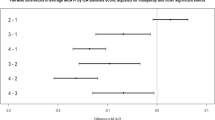Abstract
In patients with an internal carotid artery (ICA) occlusion the CO2 reactivity (autoregulatory reserve) is supposed to give information about the function of the collateral supply. To prove this hypothesis we compared the CO2 reactivity measured by transcranial Doppler sonography to the ipsilateral clinical symptoms and the patterns of infarction in cranial computed tomography (CCT).
We studied 251 cases of ICA occlusion. Of the 141 cases with normal autoregulatory reserve, 37 (27%) had recently developed an ipsilateral neurological deficit. Of the 44 cases with exhausted CO2 reactivity, 28 (64%) had experienced an event. The difference is highly significant (p<0.0001).
In 59 of the 75 patients for whom CCT images were available, we found signs of vascular-ischemic lesions. Of the 30 patients with hemodynamic infarctions, 13 showed an exhausted autoregulatory reserve, while of 19 cases with territorial infarctions only 1 and of 10 with lacunar infarctions none had an exhausted CO2 reactivity. The difference is significant (p<0.01).
Similar content being viewed by others
References
Harper AM, HI Glass: Effect of alterations in the arterial carbon dioxide tension on the blood flow through the cerebral cortex at normal and low arterial blood pressures. J Neurol Neurosurg Psychiat 28 (1965) 449–452
Ringelstein EB, H Zeumer, D Angelou: The Pathogenesis of strokes from internal carotid artery occlusion. Diagnostic and therapeutical implications. Stroke 6 (1983) 867–875
Ringelstein EB, C Sievers, S Ecker, PA Schneider, SM Otis: Noninvasive assessment of CO2-induced cerebral vasomotor response in normal individuals and patients with internal carotid artery occlusions. Stroke 19 (1988) 963–969
Widder B: Der CO2-Test zur Erkennung hämodynamisch kritischer Carotisstenosen mit der transkraniellen Doppler-Sonographie. Dtsch Wschr 110 (1985) 1553
Widder B, K Paulat, J Hackspacher, E Mayr: Transcranial Doppler CO2-test for the detection of hemodynamically critical carotid artery stenoses and occlusions. Eur Arch Psychiatr Neurol Sci 236 (1986) 162–168
Wodarz R: Watershed infarctions and computed tomography. A topographical study in cases with stenosis or occlusion of the carotid artery. Neuroradiology 19 (1980) 245–248
Zülch KJ: Über die Entstehung und Lokalisation der Hirninfarkte. Zbl Neurochir 1/3 (1961) 158–178
Author information
Authors and Affiliations
Rights and permissions
About this article
Cite this article
Kleiser, B., Widder, B., Hackspacher, J. et al. Comparison of Doppler CO2 test, patterns of infarction in CCT, and clinical symptoms in carotid artery occlusions. Neurosurg. Rev. 14, 267–269 (1991). https://doi.org/10.1007/BF00383258
Received:
Accepted:
Issue Date:
DOI: https://doi.org/10.1007/BF00383258




